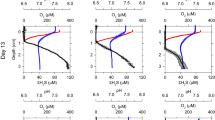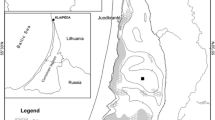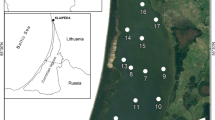Abstract
In recent decades, eutrophication has increased the extent of hypoxic and anoxic conditions in many coastal marine environments. In such conditions, the nutrient flux across the sediment–water interface is a key process controlling the biogeochemical dynamics, and thereby the level and character of biological production. In some areas, management attempts to drive the ecosystem towards phosphorus (P) limitation, which calls for reliable knowledge on the mechanisms controlling P-cycling. We report a well-controlled laboratory experiment on benthic fluxes of P, when shifting from a state of hypoxic and azoic sediments to oxic and zoic bottom conditions. Adding any of three types of macrobenthic fauna (mysid shrimp, pontoporeid amphipod and tellinid clam) to oxygenated aquarium sections resulted in benthic P fluxes that differed consistently from the azoic control sections. All species caused liberation of dissolved organically bound P (DOP) from the sediment, in contrast to the azoic systems. The shrimp and the amphipod also resuspended the sediment, which resulted in a release of P bound to particles (>0.45 μm). Dissolved inorganic phosphate (DIP) was released during hypoxic conditions, but was taken up after oxygenation, irrespective of the presence or absence of bottom fauna. In the presence of fauna, the uptake of DIP roughly equalled the release of DOP, suggesting that the benthic efflux of DOP following oxygenation and bottom fauna (re)colonisation might be considerable. This is an hitherto overlooked animal-controlled nutrient flux, which is missing from coastal marine P budgets.







Similar content being viewed by others
References
Ahlgren J, Reitzel K, Tranvik L, Gogoll A, Rydin E (2006) Degradation of organic phosphorus compounds in anoxic Baltic Sea sediments: a P-31 nuclear magnetic resonance study. Limnol Oceanogr 51:2341–2348
Ankar S (1977) The soft bottom ecosystem of the northern Baltic proper with special reference to the macrofauna. Contributions from the Askö Laboratory, University of Stockholm 19:1–62
Ankar S, Elmgren R (1976) The benthic macro- and meiofauna of the Askö-Landsort Area (northern Baltic proper): a stratified random sampling survey. Contributions from the Askö Laboratory, University of Stockholm 11:1–115
Backer H, Leppänen J-M, Brusendorff AC, Forsius K, Stankiewicz M, Mehtonen J, Pyhälä M, Laamanen M, Paulomäki H, Vlasov N, Haaranen T (2010) HELCOM Baltic Sea action plan—a regional programme of measures for the marine environment based on the ecosystem approach. Mar Pollut Bull 60:642–649
Benitez-Nelson CR (2000) The biogeochemical cycling of phosphorus in marine systems. Earth Sci Rev 51:109–135
Blomqvist S (1990) Sampling performance of Ekman grabs—in situ observations and design improvements. Hydrobiologia 206:245–254
Blomqvist S, Lundgren L (1996) A benthic sled for sampling soft bottoms. Helgoländer Meeresuntersuchungen 50:453–456
Blomqvist S, Gunnars A, Elmgren R (2004) Why the limiting nutrient differs between temperate coastal seas and freshwater lakes: a matter of salt. Limnol Oceanogr 49:2236–2241
Buffle J, Leppard GG (1995) Characterization of aquatic colloids and macromolecules. 1. Structure and behavior of colloidal material. Environ Sci Technol 29:2169–2175
Carstensen J, Conley DJ, Andersen JH, Ærtebjerg G (2006) Coastal eutrophication and trend reversal: a Danish case study. Limnol Oceanogr 51:398–408
Cembella AD, Anita NJ, Harrison PJ (1984a) The utilization of inorganic and organic phosphorus compounds as nutrients by eukaryotic microalgae: a multidisciplinary perspective: part 1. CRC Crit Rev Microbiol 10:317–391
Cembella AD, Anita NJ, Harrison PJ (1984b) The utilization of inorganic and organic phosphorus compounds as nutrients by eukaryotic microalgae: a multidisciplinary perspective: part 2. CRC Crit Rev Microbiol 11:13–81
Conley DJ, Humborg C, Rahm L, Savchuk OP, Wulff F (2002) Hypoxia in the Baltic Sea and basin-scale changes in phosphorus biogeochemistry. Environ Sci Technol 36:5315–5320
Diaz RJ, Rosenberg R (2008) Spreading dead zones and consequences for marine ecosystems. Science 321:926–929
Dyhrman ST, Ammerman JW, van Mooy BAS (2007) Microbes and the marine phosphorus cycle. Oceanography 20:110–116
Ehlin U, Mattisson I (1976) Volymer och areor i Östersjöområdet [In Swedish with English summary]. Vannet i Norden 1:16–20
Einsele W (1936) Über die Beziehungen des Eisenkreislaufs zum Phosphatkreislauf im eutrofen See [In German]. Archiv für Hydrobiologie 29:664–686
Einsele W (1938) Über chemische und kolloidchemische Vorgänge in Eisen-Phosphat-Systemen unter limnochemischen und limnogeologischen Gesichtspunkten [In German]. Archiv für Hydrobiologie 33:361–387
Gächter R, Meyer JS (1993) The role of microorganisms in mobilization and fixation of phosphorus in sediments. Hydrobiologia 253:103–121
Goedkoop W, Johnson RK (2001) Factors affecting population fluctuations of the glacial relict amphipod Monoporeia affinis (Lindström) in Sweden’s largest lakes. Ambio 30:552–558
Gunnars A, Blomqvist S (1997) Phosphate exchange across the sediment–water interface when shifting from anoxic to oxic conditions—an experimental comparison of freshwater and brackish-marine systems. Biogeochemistry 37:203–226
HELCOM (2007) HELCOM Baltic Sea Action Plan, HELCOM ministerial Meeting. Krakow, Poland, 15 November 2007. Helsinki, Finland. www.helcom.fi/BSAP/en_GB/intro/
Hietanen S, Laine AO, Lukkari K (2007) The complex effects of the invasive polychaetes Marenzelleria spp. on benthic nutrient dynamics. J Exp Mar Biol Ecol 352:89–102
Hollibaugh JT, Buddemeier RW, Smith SV (1991) Contributions of colloidal and high molecular weight dissolved material to alkalinity and nutrient concentrations in shallow marine and estuarine systems. Mar Chem 34:1–27
Hopkins TL, Baird RC, Milliken DM (1973) Messenger-operated closing trawl. Limnol Oceanogr 18:488–490
Howarth R, Chan F, Conley DJ, Garnier J, Doney SC, Marino R, Billen G (2011) Coupled biogeochemical cycles: eutrophication and hypoxia in temperate estuaries and coastal marine ecosystems. Front Ecol Environ 9:18–26
Jensen HS, Mortensen PB, Andersen FO, Rasmussen E, Jensen A (1995) Phosphorus cycling in a coastal marine sediment, Aarhus Bay, Denmark. Limnol Oceanogr 40:908–917
Kankaala P (1983) Resting eggs, seasonal dynamics, and production of Bosmina longispina maritima (P.E. Müller) (Cladocera) in the northern Baltic proper. J Plankton Res 5:53–69
Karlson K (2007) Diurnal bioturbating activities of Monoporeia affinis: effects on benthic oxygen and nutrient fluxes. Mar Ecol Prog Ser 331:195–205
Karlson K, Rosenberg R, Bonsdorff E (2002) Temporal and spatial large-scale effects of eutrophication and oxygen deficiency on benthic fauna in Scandinavian and Baltic waters—a review. Oceanogr Mar Biol Annu Rev 40:427–489
Karlson K, Hulth S, Ringdahl K, Rosenberg R (2005) Experimental recolonisation of Baltic Sea reduced sediments: survival of benthic macrofauna and effects on nutrient cycling. Mar Ecol Prog Ser 294:35–49
Karlson K, Hulth S, Rosenberg R (2007a) Density of Monoporeia affinis and biogeochemistry in Baltic Sea sediments. J Exp Mar Biol Ecol 344:123–135
Karlson K, Bonsdorff E, Rosenberg R (2007b) The impact of benthic macrofauna for nutrient fluxes from Baltic Sea sediments. Ambio 36:161–167
Koroleff F (1983) Determination of phosphorus. In: Grasshoff K, Ehrhardt M, Kremling K (eds) Methods of seawater analysis, 2nd edn. Verlag Chemie, Weinheim, pp 125–139
Kristensen E (2000) Organic matter diagenesis at the oxic/anoxic interface in coastal marine sediments, with emphasis on the role of burrowing animals. Hydrobiologia 426:1–24
Laine AO, Sandler H, Andersin A-B, Stigzelius J (1997) Long-term changes of macrozoobenthos in the Eastern Gotland Basin and the Gulf of Finland (Baltic Sea) in relation to the hydrographical regime. J Sea Res 38:135–159
Larsson U, Elmgren R, Wulff F (1985) Eutrophication and the Baltic Sea: causes and consequences. Ambio 14:9–14
Lehtoranta J, Heiskanen A-S (2003) Dissolved iron: phosphate ratio as an indicator of phosphate release to oxic water of the inner and outer coastal Baltic Sea. Hydrobiologia 492:69–84
Lindström M, Lindström A (1980) Swimming activity of Pontoporeia affinis (Crustacea, Amphipoda)—seasonal variations and usefulness for environmental studies. Ann Zool Fenn 17:213–220
Lindström M, Sandberg-Kilpi E (2008) Breaking the boundary—the key to bottom recovery? The role of mysid crustaceans in oxygenizing bottom sediments. J Exp Mar Biol Ecol 354:161–168
Moisander PH, Paerl HW, Dyble J, Sivonen K (2007) Phosphorus limitation and diel control of nitrogen-fixing cyanobacteria in the Baltic Sea. Mar Ecol Prog Ser 345:41–50
Nausch M, Nausch G (2006) Bioavailability of dissolved organic phosphorus in the Baltic Sea. Mar Ecol Prog Ser 321:9–17
Paytan A, McLaughlin K (2007) The oceanic phosphorus cycle. Chem Rev 107:563–576
Pitkänen H, Lehtoranta J, Räike A (2001) Internal nutrient fluxes counteract decreases in external load: the case of the estuarial eastern Gulf of Finland, Baltic Sea. Ambio 30:195–201
Põder T, Maestrini SY, Balode M, Lips U, Bechemin C, Andrushaitis A, Purina I (2003) The role of inorganic and organic nutrients on the development of phytoplankton along a transect from the Daugava River mouth to the open Baltic, in spring and summer 1999. ICES J Mar Sci 60:827–835
Salemaa H, Vuorinen I, Välipakka P (1990) The distribution and abundance of mysis populations in the Baltic Sea. Ann Zool Fenn 27:253–257
Savchuk OP (2005) Resolving the Baltic Sea into seven subbasins: N and P budgets for 1991–1999. J Mar Syst 56:1–15
Savchuk OP, Wulff F (2007) Modeling the Baltic Sea eutrophication in a decision support system. Ambio 36:141–148
Sokal RR, Rohlf FJ (1995) Biometry, 3rd edn. W. H. Freeman and Company, New York
Stigebrandt A, Gustafsson BG (2007) Improvement of Baltic proper water quality using large-scale ecological engineering. Ambio 36:280–286
Sundby B, Anderson LG, Hall POJ, Iverfeldt A, Vanderloeff MMR, Westerlund SFG (1986) The effect of oxygen on release and uptake of cobalt, manganese, iron and phosphate at the sediment–water interface. Geochim Cosmochim Acta 50:1281–1288
Tengberg A, De Bovee F, Hall P, Berelson W, Chadwick D, Ciceri G, Crassous P, Devol A, Emerson S, Gage J, Glud R, Graziottini F, Gundersen J, Hammond D, Helder W, Hinga K, Holby O, Jahnke R, Khripounoff A, Lieberman S, Nuppenau V, Pfannkuche O, Reimers C, Rowe G, Sahami A, Sayles F, Schurter M, Smallman D, Wehrli B, Wilde PD (1995) Benthic chamber and profiling landers in oceanography—A review of design, technical solutions and functioning. Prog Oceanogr 35:253–294
Valderrama JC (1981) The simultaneous analysis of total nitrogen and total phosphorus in natural-waters. Mar Chem 10:109–122
Valiela I (1995) Marine ecological processes, 2nd edn. Springer, New York
van Veen J (1933) Onderzoek naar het zandtransport von rivieren. De Ingenieur 48B:151–159
Viitasalo-Frösén S, Laine AO, Lehtiniemi M (2009) Habitat modification mediated by motile surface stirrers versus semi-motile burrowers: potential for a positive feedback mechanism in a eutrophic ecosystem. Mar Ecol Prog Ser 376:21–32
Viktorsson L, Almroth ER, Tengberg A, Vankevich R, Neelov I, Isaev A, Kravtsov V, Hall POJ (2012) Benthic phosphorus dynamics in the Gulf of Finland, Baltic Sea. Aquat Geochem. doi:10.1007/s10498-011-9155-y
Walve J, Larsson U (2007) Blooms of Baltic Sea Aphanizomenon sp. (cyanobacteria) collapse after internal phosphorus depletion. Aquat Microb Ecol 49:57–69
Weiss RF (1970) Solubility of nitrogen, oxygen and argon in water and seawater. Deep Sea Res 17:721–735
Wulff F, Bonsdorff E, Gren I-M, Johansson S, Stigebrandt A (2001) Giving advice on cost effective measures for a cleaner Baltic Sea: a challenge for science. Ambio 30:254–259
Acknowledgments
The Tvärminne Zoological Station provided excellent laboratory facilities and a generous atmosphere. We are grateful to the staff of the Chemical Laboratory at the Department of Systems Ecology, Stockholm University, for skilful determination of different P fractions. Ragnar Elmgren provided constructive comments and linguistic improvements. The Stockholm University Marine Research Centre subsidised ship time. ML received a grant from the Walter and Andrée de Nottbeck Foundation. This study is a contribution from the BOX project, which is financially supported by the Swedish Environmental Protection Agency. Financial support was also provided to PH by the EU through the FP7 project HYPOX. Finally, PH sincerely enjoyed and benefited from the years of scientific collaboration with Bjørn Sundby. Those years were special. The topics of this paper, P-cycling and bioturbation, are among the favourite research themes of Bjørn, and we dedicate this paper to him.
Author information
Authors and Affiliations
Corresponding author
Rights and permissions
About this article
Cite this article
Ekeroth, N., Lindström, M., Blomqvist, S. et al. Recolonisation by Macrobenthos Mobilises Organic Phosphorus from Reoxidised Baltic Sea Sediments. Aquat Geochem 18, 499–513 (2012). https://doi.org/10.1007/s10498-012-9172-5
Received:
Accepted:
Published:
Issue Date:
DOI: https://doi.org/10.1007/s10498-012-9172-5




